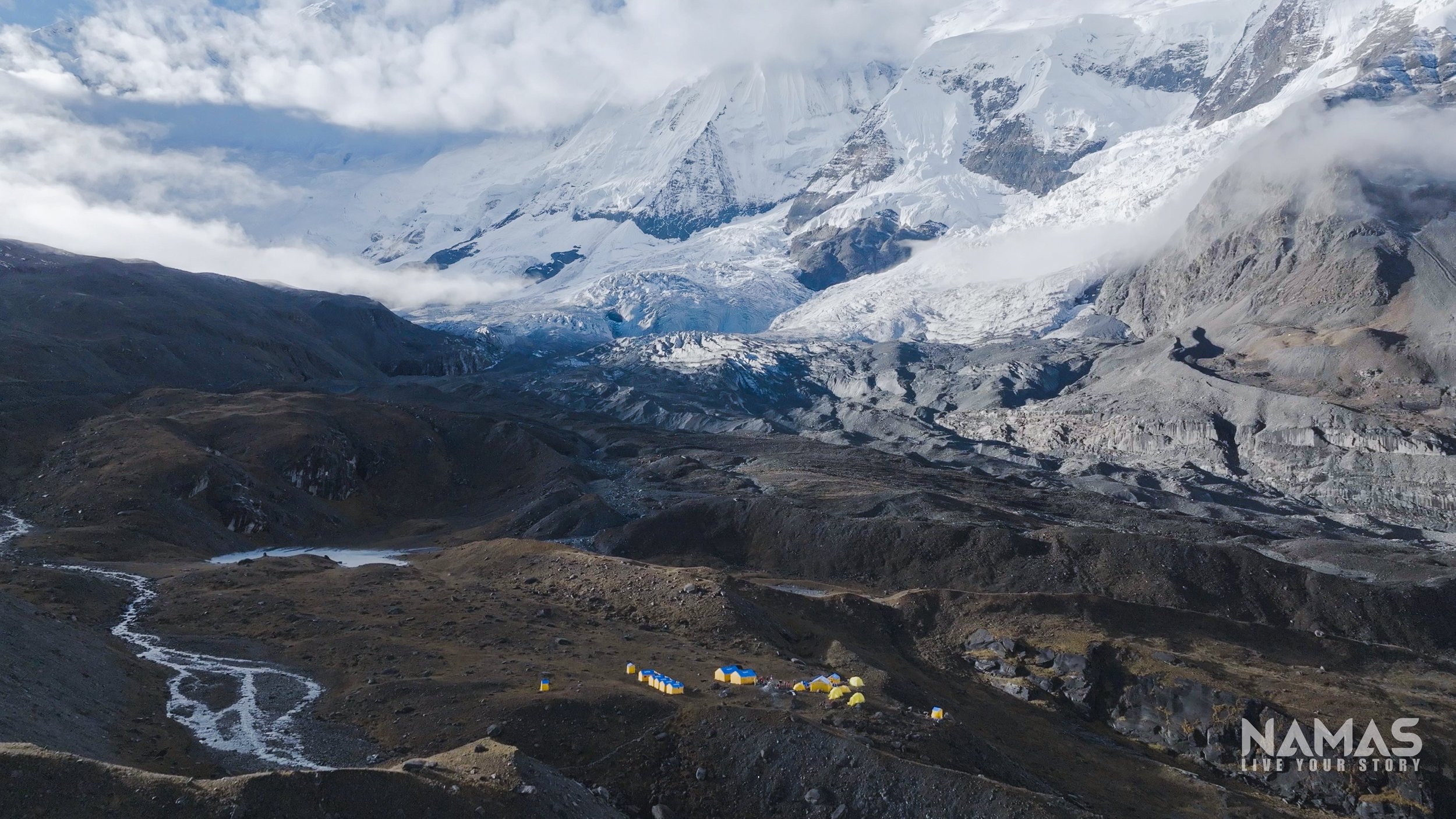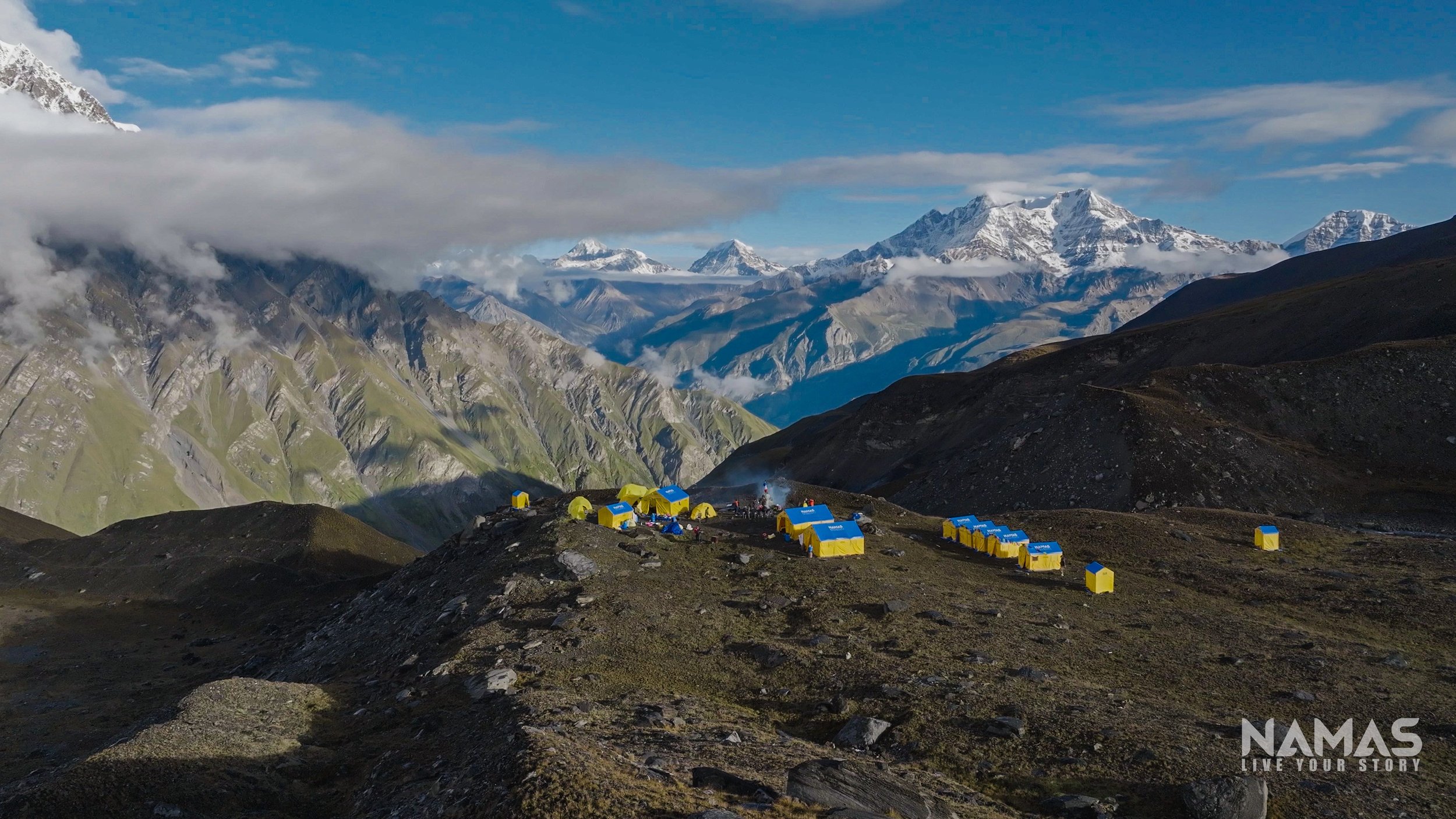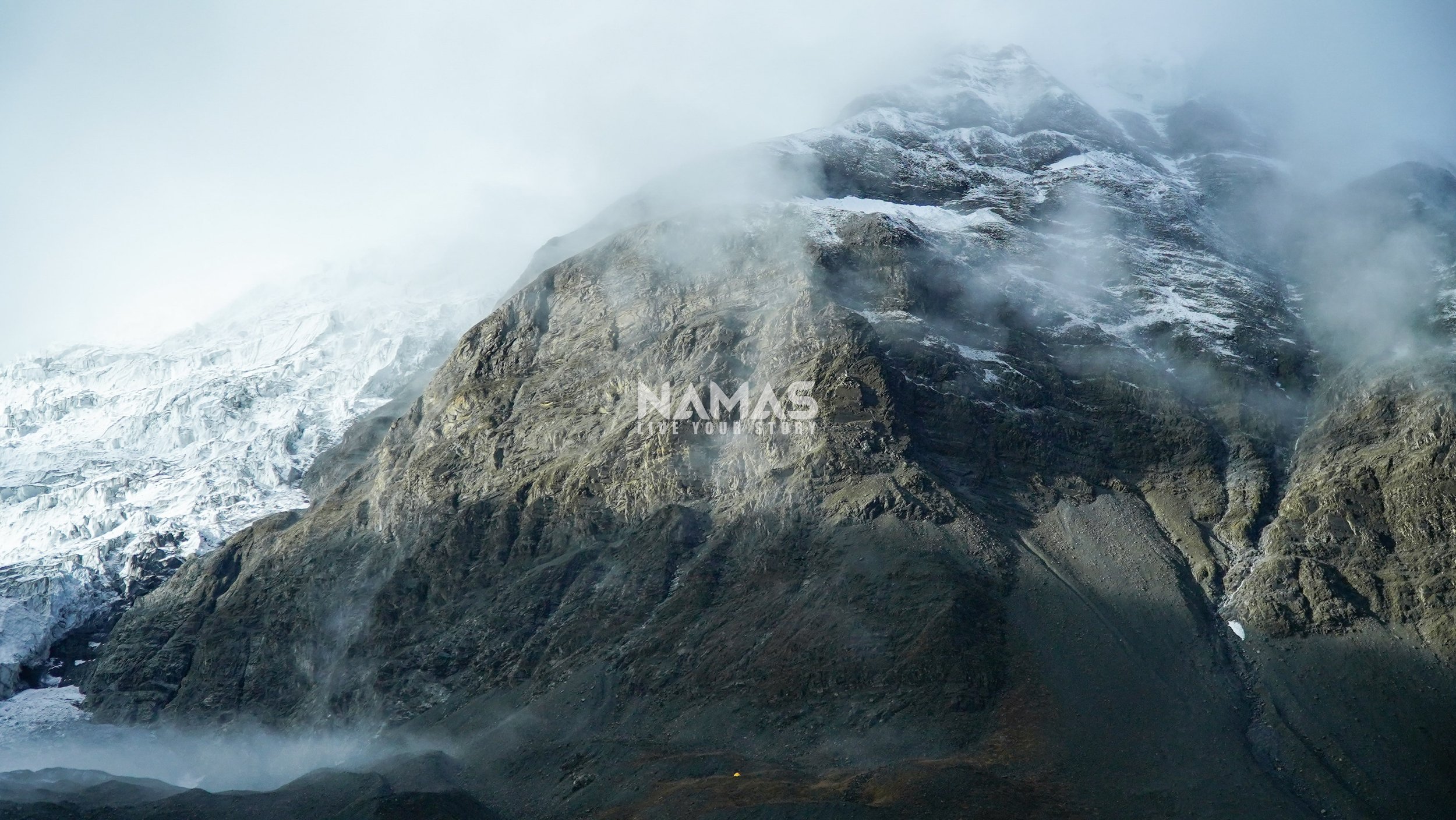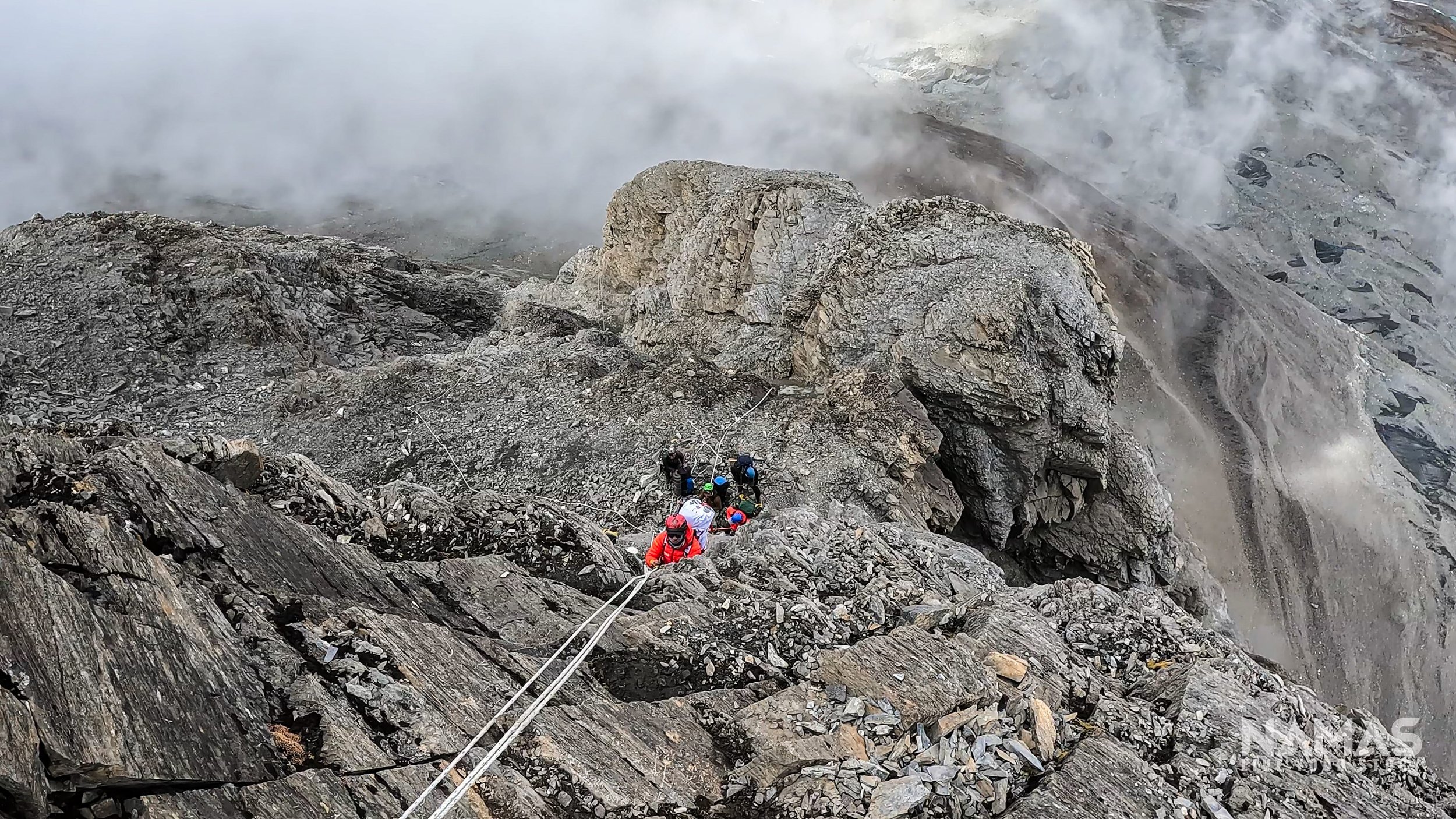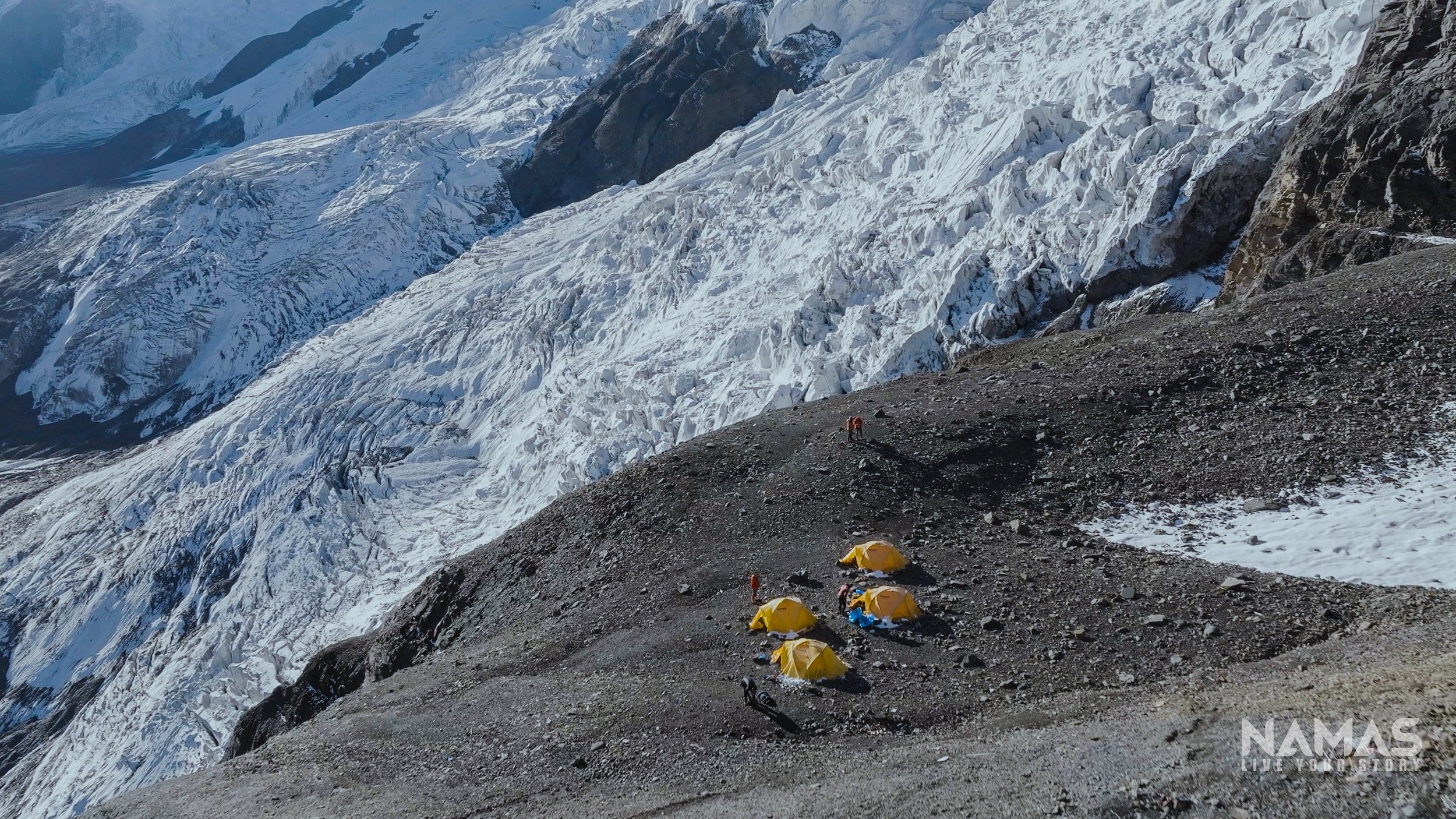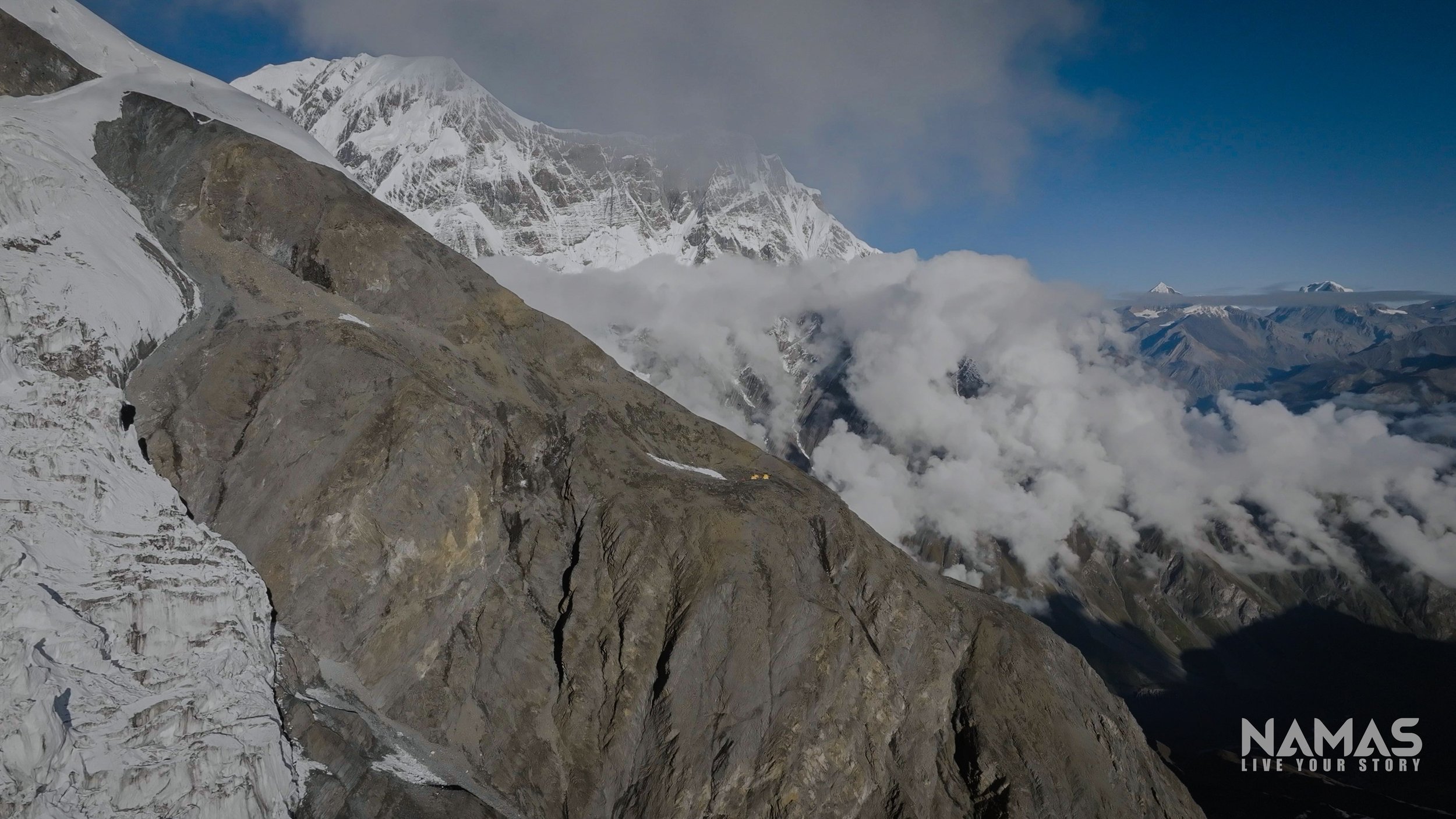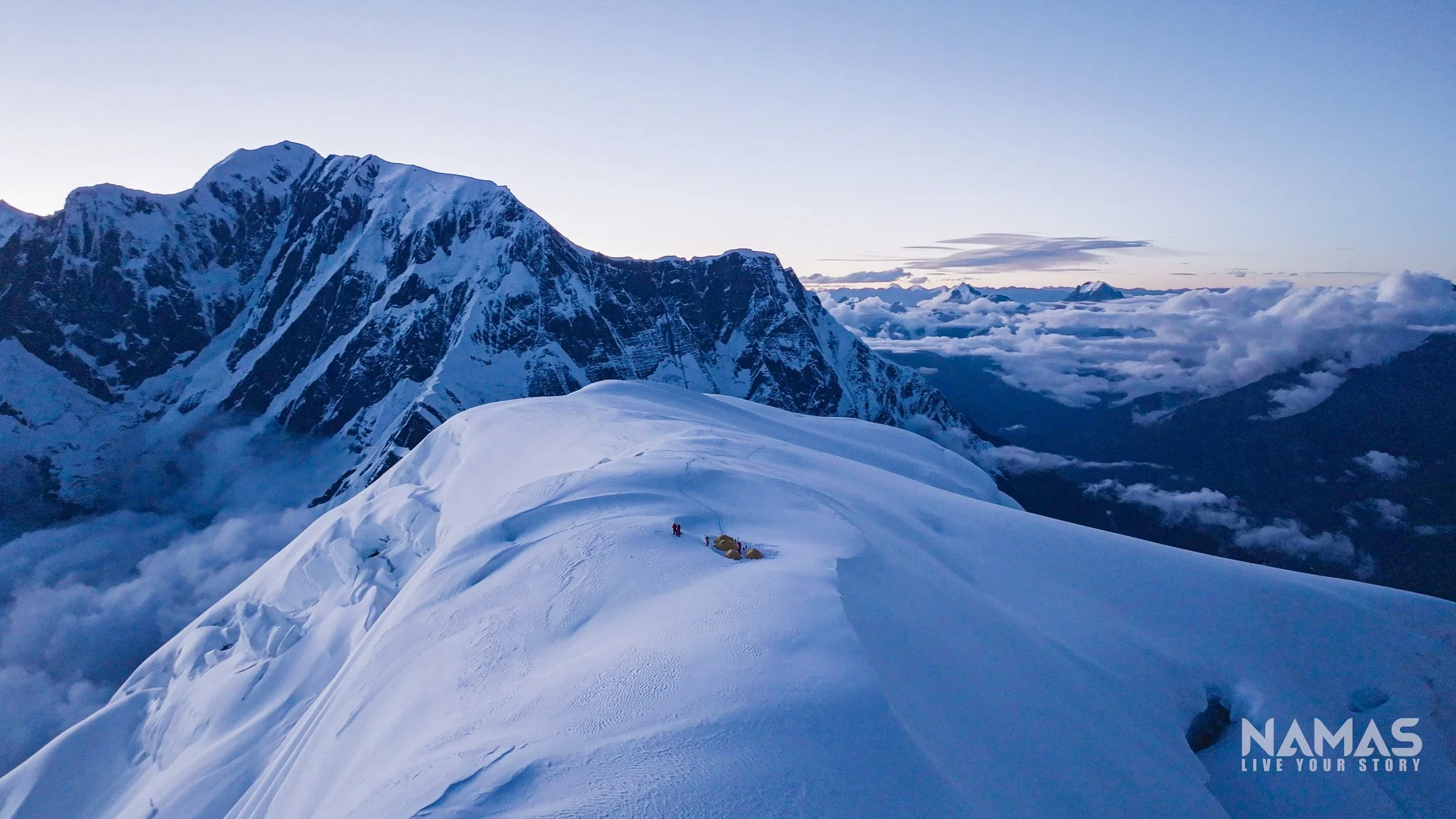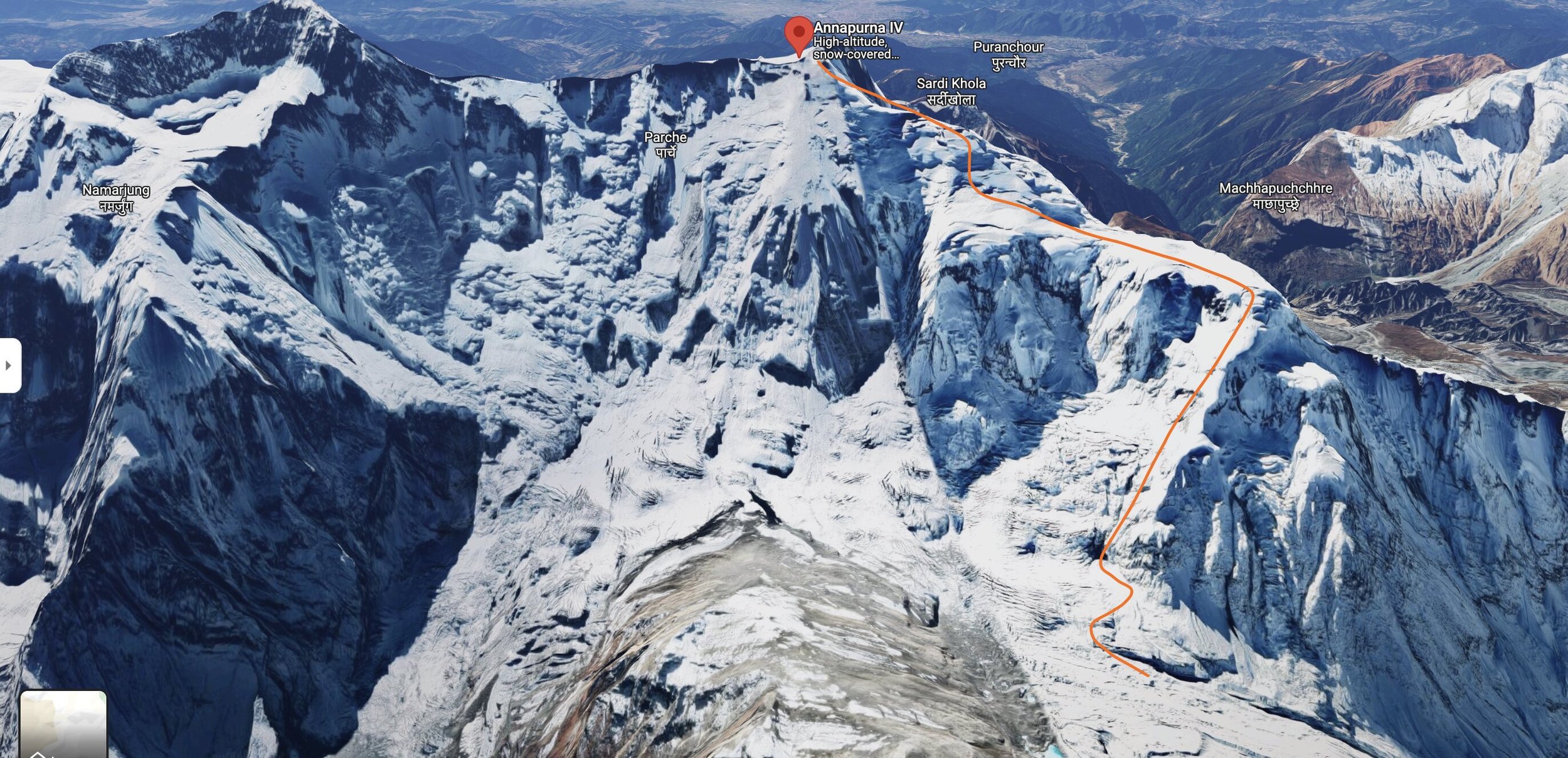
ANNAPURNA IV 7525M
HIGHLIGHTS
Rarely climbed 7500M Peak with few objective dangers. Just Namas team during autumn departures
Our 2023 Fall AIV expedition was a success with 3 out of 4 climbers summiting. 4th Member reached up to 7300M+ and had to return due to incoming bad weather and white out situation at 7300M elevation.
1:1 Climbing support
Personal supplemental oxygen (1 cylinder and regulator)
Skip entry level 8000M and get ready for Everest or another 8,000m peak
Camp 1,2 3 & 4 strategy. Heated Dining tent, solo tent at base camp
Strong and experienced Climbing Sherpa Team
OVERVIEW
Annapurna IV 7527M is the perfect mountaineering objective for climbers who wants the thrill of climbing at extreme altitude with fewer crowds and relatively less technical difficulty compared to other peaks in the Annapurna massif. Annapurna IV is part of the great Annapurna massif range, standing tall between Annapurna II 7937M/26040FT on the western side and Annapurna III 7555M/24787FT to the eastern face. The climbing route has fewer objective dangers and is relatively a semi-technical climb. To clear out the confusion amongst the Annapurna massif range (Annapurna I, II, III, IV, and Gangapurna) IV is the least dangerous and least technical. This mountain is not climbed as often as other peaks in the region.
Pre-requisite requirements (two or more): Lobuche East & Island Peak, Chulu West, Khumbu 3 Peak expeditions, Aconcagua (Similar semi-technical 6000M peaks or higher), Denali, Himlung Himal 7126M or higher.
There is no question about the beauty and challenges of climbing this 7525M+ giant but this expedition is by no means a walk in the park. Graded at TD+/4 the climbing route consists of some technical climbs as well as glacier routes, rocky vertical climbs, and steep exposed ridges. This mountain will shape you with the right experience to climb 8000M peaks or even Mt. Everest.
-
2023 Autumn season. Namas Adventure team was the only team to summit this year. 3 out of 4 client members summited Annapurna IV.
4th Member reached upto 7300M+ and had to return due to incoming bad weather and white out situation at 7300M elevation.
-
Autumn 2025
4th October - 2nd November
Spring 2026
20th April - 19th May
Autumn 2026
5th October - 3rd November
-
USD 12,950 P/P
Deposit required: USD 1,500 P/P
All-inclusive. Guaranteed departure. No extra hidden costs.
Please inquire about prices in your local currency. We accept payment in £GBP/ €EUROS/ $AUD
-
IFMGA or NMA certified Guide leader
Namas Branded merchandise (Down Jacket, Cap, Buff)
1:1 Sherpa/client ratio. (Additional Sherpa Guide can be arranged, extra charges apply)
Head chef and 2 kitchen helpers ( Helpers increase with the number of climbing team members )
1X Personal Oxygen cylinder and regulator
2 nights before the expedition and 1 day after the expedition. Single-room hotel in Kathmandu. (Should clients return early from their expedition, clients will be responsible for their extra Kathmandu hotel bookings)
1 Night at Pokhara hotel
All trekking and climbing permits
All internal-local transportation to and from the trekking trailhead
Solo tent at BC, and 2 person tent at higher camps
40 kgs personal weight (Extra additional weight, clients will need to hire an additional porter. Estimated $1000 USD for 27-28 days)
Meals during camping days (Chicken, mushroom, vegan options, etc)
Burners and expedition equipment
Walkie-talkie/ Satellite phone
Breakfast, Lunch, and Dinner on trek and expedition days.
Lodge accommodation during the trek
Arrival pick-up and departure
Internal flights
Basic First aid kit
Welcome or Farewell leave Dinner
-
Visas and travel insurance
Summit Bonus ($1000 per member)
Entertainment and food (Kathmandu & Pokhara)
Bottled drinks and beverages
Evacuation (will be done in your account)
Single supplement Charges
Laundry, Phone services, Personal expenditure transactions
Optional trips
Tea breaks, chocolates or other snacks, and any meals besides breakfast, lunch, and dinner.
Delay and cancellation because of natural phenomenon
International flights to Kathmandu
-
138 Summits
ITINERARY
Day 1-2 Arrive in Kathmandu, Transfer to Hotel for expedition briefing.
Day 3 Drive Kathmandu to Besi Sahar (8 hours)
Day 4 Drive to Humde (6 hours)
Day 5 Humde to Manang acclimatisation trek
Day 6 Humde to Base camp 4850M
Day 7 - 25 Climbing Period for Annapurna IV Summit (7,126m) (19 Days of climbing, Base Camp. Puja ritual ceremony, contingency day, Training, and preparation for a summit bid. We will aim 1 rotations between Camp 1 & 4)
Day 26 Base Camp to Humde
Day 27 Humde to Besi Sahar
Day 28 Drive Besisahar to Pokhara
Day 29 Sunrise in Pokhara and flight to Kathmandu
Day 30 Departure
ACCOMMODATIONS
Day 1 - 2 and 31 - 32 (Hotel)
Day 8 - 28 (Alpine Camping)
-
Dr. Ronald Pieters 🇬🇧 🇳🇱 (2023 Annapurna IV)
Another great expedition! This was my third time with Namas and it exceeded expectations.
The kindness, skill, and unity of the Namas team was palpable all the time. They again proved to be super-efficient, resourceful, always with a smile, and radiating great team spirit. The sherpas were outstanding. Kind and helpful, with great skill and insight and a good sense of humor. A lot of them knew each other, it had a family feel to it.
Paljor who helped me last year on Himlung Himal is such a great chap. Rental gear was good, a warm comfy Kailash sleeping bag, Black Diamond crampons, and Harness and helmet. Basecamp set up was excellent and well organised. A nice roomy tent for each and a great communal-dining tent in stunning location.
We pushed up high quite fast because of a short favourable weather window and finished the expedition a week ahead of schedule! A tough but very interesting mountain. Recommended. I especially got to appreciate and love ‘the wall’, between basecamp and camp 1.
It was great to have Bisesh as a team member! Looking forward to my next expedition with Namas.
-
Helicopter charter from Humde to Kathmandu - Please inquire
Annapurna IV + Chulu West
Annapurna IV + Ama Dablam
-
138 Summits
ANNAPURNA IV BLOG ARTICLES
Experiences, fitness level and skills required for Annapurna IV/4 expedition
How many climbers have summited Annapurna 1,2,3,4 and south?
ANNAPURNA IV DIFFICULTY? How hard is ANNAPURNA IV climb?
You will need to be very comfortable climbing with crampons, ascending on jumar, and descending with packs on your back. Steeper rocky climbing sections are mostly between camps 1, 2, and 3. Ascending and descending on fixed ropes are to be expected like most Himalayan expeditions. After this expedition, you can skip the entry-level 8000ers climb and consider yourself prepared for the Everest Expedition.
During the expedition, we will require 3 or 4 higher camps. The climbing route is a relatively safe route with impressive views, steep rocky vertical climbs, and some exposed ridge sections. Since Annapurna IV does not have many teams climbing the peak, a considerable workload will be upon us. Sherpa team members will be responsible for a fixed line to the summit (under favorable weather/snow conditions). Personal supplemental oxygen will be available to each team member and we encourage client team members to use it from the final camp (3 or 4). Additional personal oxygen cylinders can be arranged at additional cost.
History: Annapurna IV was first climbed in 1955 by a German expedition led by Heinz Steinmetz via the North Face and Northwest Ridge.
HOW DOES IT WORK?
1. Initial Inquiry and Planning
At NAMAS Adventure, we start by understanding your aspirations and goals. From your first conversation with our expert team, we provide personalized recommendation tailored to your interests. Once the perfect expedition is identified, a deposit secures your spot. We then work closely with you to plan and prepare every detail—from gear selection and training advice to arranging insurance, permits, and logistics.
2. Preparing for the Journey
As your expedition date approaches, we’ll help you finalize all preparations. This includes collecting the final balance payment (typically due 60-90 days before your trip), ensuring all necessary documents are in order, and addressing any remaining questions. Our team is available via email or phone calls to make sure you’re fully prepared and confident for the adventure ahead.
3. On-Expedition Support
Arrive at your destination ready to begin! From pre-expedition briefings and gear checks to the full support of our experienced guides and ground team during your climb, we’re here to ensure everything runs smoothly. With flexibility to adapt to any changes or needs, we’re committed to making your adventure seamless, enjoyable, and unforgettable

EXPEDITION STRATEGY
Climbing the steep wider ridge of the mountain we arrive at camp 2. The climbing terrain surface is mostly covered with snow and ice. The climb is mostly assisted by fixed lines and some sections are very steep and climbers will also have to pass a short ridge section. The views from camp 2 is just stunning overlooking the western Himalayan section of Chulu West, East, Himalchuli Himal, Pisang peak and other surrounding peaks.
Camp 2 5500M to Camp 3 6600M
As soon as climbers leave camp 2 the first few sections are steep and demanding climbs. Once past the steep section the climb is mostly on a gradual uphill and broad section of the mountain before reaching camp 3. The summit is visible as we climb up and camp 3 is set up just below the broad pleated headwall.
Camp 3 to Camp 4, 7100M & Summit 7525M
AIV Camp 3. Fishtail Peak and Annapurna 3 headwall in the background.
Get ready for a long steep and tough climb to the summit. From camp 3 to the summit and back, climbers can expect 14 - 18 hours of climbing. Soon after we leave camp 3, members are expected to climb 1000M of a steep and long climb. This is no easy day. Lines will be fixed on the dangerous and overhanging part of the mountain walls. On a clear day from the summit, the whole of the Annapurna (I, II, III, Gangapurna, and Tilicho Peak) massif range, Manaslu 8163M, Machhpucchre, Ganesh Himal, and Dhaulagiri are visible. We will aim to reach back to Camp 4.
Annapurna IV Summits. Top Middle. False Summit 7300M. Real Summit 7525M
From base camp, we climb up the moraine to reach the foot of the mountain. Once at the bottom, we will have to climb our first rocky steeper section and then a glacier climb before reaching Camp 1. This is the first steep technical climb of the expedition. The terrain is mostly rocky and snowy sections. Annapurna III will be on the right-hand side while Annapurna II is very present on the left-hand side with Manaslu further towards the southeast.
Camp 1 5500M to Camp 2 6100M
ADD'S ON . . .
Personal Sherpa $4500 p/p
Extra Oxygen bottle $550 per bottle
All heli charter includes passengers luggage. *Prices stated $ is US Dollars
EQUIPMENT LIST . . .
Mountain climbing Gears
- Helmet (Black diamond, Petzel)
- Alpine Ice Axe (65-70cm)
- A mountaineering harness, with adjustable leg loops.
- Carabiners: 3 locking and 6 regular
- Rappel device: ATC or figure 8
- crampons: 10 or 12 point
Mountaineering boots
- Mountaineering boots suitable for above 8000m; La Sportiva or equivalent
- Hiking shoes for the trek to base camp with ankle protection
- Thermal mountaineering socks or equivalent: 6 pairs
- Liner socks or equivalent: 6 pairs
Body Layers:
- Expedition suits - North face Himalayan suit or similat
- 4 merino base layers: top / bottom set
- 5 mid layer top: breathable Underwear
- Lightweight Nylon Pants: 1 pair
- Hooded Soft Shell jacket To be worn over other layers
- Soft Shell Guide Pants: Gore Tex and breathable
- Hooded Hard Shell: Gore Tex and breathable
- Hard Shell Pants: Gore Tex and breathable, big enough to wear over your guide trousers
- Insulated Down Jacket with hood: North Face Himalayan parka or equivalent
- Insulated synthetic Pants: Worn primarily when climbing below Camp 2
- Long jones equivalent to Rab’s Polartec or equivalent: 2 pairs
Headgear and Hand wear:
- Wool hat (ski hat)
- Sunhat: To shade your face / neck from the sun on a hot day
- Buff: To protect your neck / face from the sun
- Glacier glasses: Full protection with side covers or wrap around
- Ski goggles: To be worn on summit day in the event of high winds
- Lightweight synthetic liner gloves: For wearing on a hot day; 2 pairs
- Soft shell gloves: To wear for moderate cold / wind
- Shell glove with insulated liner: To wear for severe cold / strong wind
- Expedition Mitts for bad weather
Personal Gear:
- Expedition Backpack: 65L pack should be large enough.
- Trekking Backpack: To carry on the trek to base camp. Simple and light.
- Sleeping Bag: Rated to at least -40°F. Goose down or synthetic
- Compression stuff sacks: 3 large ones; for reducing volume of the sleeping bag, down parka, etc., in your pack.
- High Quality sleeping pad (1 for base camp and 1 for high camps): Full length is preferred.
- Closed cell foam pad: To be used in conjunction with the inflating pad for warmth and comfort when sleeping.
- Trekking poles with snow baskets: Adjustable poles
- Cup: Plastic insulated cup for drinking
- Bowl: A plastic bowl for eating dinner or breakfast
- Spoon: Plastic spoon
- Head torch: 1 normal for base camp and 1 with remote battery systems for climbing at night. This will be used whilst climbing at night
- Sunscreen: SPF 50 or above
- Lip balm with sunblock
- Water bottles: 2 wide mouth bottles with 1 litter capacity
- Water bottle parkas (2): fully insulated with zip opening
- Thermos: 1 litre (buy a good ones to keep your water warm for longer hours)
- Pee bottle: 1 litre minimum bottle for convenience at night in the tent
- Toiletry bag: Include toilet paper and hand sanitizer and small towel
- Hand warmers & toe warmers
- Pen Knife or multi tool (optional)
- Camera: bring extra batteries and memory cards
- Personal solar charging system (optional but recommended)
- Travel Clothes
- Duffel bags (2) with locks: To transport equipment
- Base Camp extra Items: Kindle, I pad, smart phone, etc
- Snack food: Please bring a few days of your favourite climbing snack food such as bars, gels, nuts, beef jerky, etc. A variety of salty and sweet is recommended to give you extra energy.
- Small personal first aid kit: Include athletic tape, Band-Aid’s, Ibuprofen, blister care, personal medications, etc
- Medications and Prescriptions: Bring antibiotics (Azithromycin, etc.), and altitude medicine such as Diamox and dexamethasone*
BLOG LINKS . . .
Related blog articles:
Altitude sickness
$20 BY 2020, a case for our himalayan porters
Mountain climbing gears checklist
EQUIPMENT HIRE . . .
Bundle Price per expedition: £300 | $350 p/p**
Client’s will try and receive full gears when they arrive in Nepal.
“Rental gears are exclusively used by and for Namas adventure clients rental purpose only. We do not rent gears to other operators. We only provide high-quality gears.”
Benefits of renting gears with us:
- Save money on gears that will end up costing you £2000 | $2700
- Save cost on extra airline baggage weights $60 per kg (on average)
- Saves you time and energy to go through all the research and hassle of finding the gears
Gears Included (Bundle package)
- -23C/-30C Kailas Mountain 900 Down Sleeping Bag
- 12 Point Kantz Crampons
- Climbing Helmet
- Climbing harness
- 3X Carabiners
- Z-lite sleeping foam mat
- L Duffle bag
FAQs
When is the best time to plan for Annapurna IV Expedition? . . .
March - May (Spring) and September - October (Autumn)
Which route will Namas team choose? I can see the mountain is very steep and exposed, What is your climbing strategy? . . .
Annapurna IV is a classic mountaineering climb with relatively fewer objective dangers. We will climb through the north west ridge of the mountain. Fixed rope lines will be setup by our rope fixing team all the way to the summit.
Our stragey will be to use Camp 1,2 and 3. Camp 4 is situationala and will only be decided once expedition leader asseses mountain condition. Climbing through the standard route of north west ridge. More detailed information on Expedition stragey coloumn above
How long is a typical day on the mountain?? . . .
Time duration and distance varies from camp to camp, but on normal climbing day can expect an average of 6 hours climb. Summit attempt days are usually the longest one, as we have to descend down to our chosen camp. (Camp 3 or 2 depending on our overall progress)
What is summit day like? . . .
Summit day in Annapurna is the straightforward climb. We will be mostly climbing through ice and snow terrains and will be a early day (am) start to the summit and back to camp 3 or 2/
Contingency Days ? . . .
We have added contingency day on our 21 days of climbing period. If the weather is all great then from base camp to summit and back can be achieved in 14 - 16 days if that is not the case then we have already added an extra 5 days as a contingency so that our team can have extra days for summit attempt when things don't go as planned. Yes, we would highly recommend return flight to stay flexible as this will give you the opportunity to extend/shorten your departure date.
Guides/client Ratio Qualification and level of English? . . .
On this expedition we aim to have max 10 climbers, we have 1 Main guide who will be IMFGA or NMA certified. He will be the main leader of the team. We believe that Nepalese certified guides are more than capable in this day and age and have an excellent level of English. We are committed to responsible tourism and want to enhance and prioritise local Nepalese leaders first, but if the clients request a western guide personally then we can have that arranged.
Sherpa ratio 1:1. Our Sherpas are NMA (Khumbu climbing centre trained/certified). Additional Personal Sherpa for 1:1 can be arranged who will be solely responsible for the clients but extra additional charges apply. Our Sherpas have an intermediate level of English. Can understand, reply and instruct very well.
Summit tips for Personal guide? . . .
Suggested Additional Summit tips $1000.
What are the skills/prior experience required for this climb? . . .
You'll need to be comfortable climbing with crampons, ascending on jumar and descedind/abseiling skills. Although ropes are fixed line the all way to the summit, you need to be able to climb steep rock and hard ice, carrying a big pack. Previous high-altitude mountaineering experience is a must and your must be capable of climbing alpine AD routes. Please feel free to contact us if you have any questions around your experience for climbing this expedition.
How do I know this is the right trip for me? . . .
Annapurna IV Expedition climb being a less technical climb relatively, this mountaineering adventure really depends on your ambition to go on a great challenging climbing adventure. To help you clarify if this is the right expedition for you, [our grading][2] system can help you determine if this is the right expedition and if it is the right time to take upon trips of such nature. If you are yet unsure please do contact our team and we will walk you through where you are in your current experience level and guide you into choosing the right expeditions.
How many guides/ Sherpas will be assigned to our group? . . .
For this Expedition 1:1 Sherpa guides are assigned to our group.
How many in a group? . . .
Min 4 - Max 10
Who is this trip for? . . .
Any climbers 18+ with relevant climbing experiences.
Who goes on this Expedition? . . .
Climbers from all over the globe with different backgrounds, interest and mountaineering skill level join our expeditoin. Some climbers even join this expedition after climbing Everest or other higher expedition because all climbs are fundamentally different and challenging.
Can my friends and family join me on the trek into Base Camp? . . .
Yes, it is possible. Please email us about this and give you relevant informations.
Can I contact other climbers to join this expedition? . . .
Yes, we highly encourage that. Maybe its your friend with whom you have been on amazing/challenging adventure trips before, a you met during your other expeditions, a challenge you seek together or any other ideas where you think the other person might enjoy this amazing climb.
Baggage allowance by Namas Expedition team for this Expedition? . . .
We allow 40kgs of personal weight for this expedition.
Is it possible to organise a private expedition? . . .
We will be more than happy to organise private Annapurna IV expedition but we will require 4 confirmed members with additional cost for 2 high altitude porter Sherpas. Their primary role will be to support the rope fixing team to take the loads to higher camps.
As long as it is with in the suitable season. This expedition requires extra cost as we will have to organise seperate logistical and planning for private expedition request. Please contact our team for any private trips or expeditions.
What fitness/conditioning level is needed for this climb? . . .
You need to be in excellent shape for this climb. We recommend fitness level of 4. Although this expedition climb is supported by Sherpa guides and rope climbing on any high mountain peak it is critical that you are in the best shape possible. Sherpa support is moderate on this climb, you are expected to be able to carry all of your personal gear needed for the climb. Our Sherpa teams will primarily be responsible for transporting our group gear.
Technical preparation and trainings for Annapurna IV Expedition? . . .
- Basic Bouldering and rope climbing session in your local climbing centre.
- Commitment to regular endurance and strengthening training.
- Climbing with crampons on and understand the nature of physical demands that the mountain requires.
- Ascending with jumar and descending on fixed rope
- 4000 - 6500 M peak of mountain summit. Your adaptability to high altitude and climbing on high steep terrains.
How heavy will my bagpack be? . . .
We will be moving a lot of our personal gears during acclimatisation rotation and safely leave it in our personal tent. This lightens the load and normally your packs are 5kgs - 10kgs.
How do you I train for a trip like this? . . .
We have written blog post on training for mountaineering which can give yo a guidance and tips on how long to what type of training you should undertake to train yourself well for challenging mountaineering expeditions.
Physical fitness needed for this Expedition? . . .
You need to be in your top shape for this climb. Due to the semi-technical nature of the peak, it is very important that you are in the best shape possible. Also, as Sherpa support is moderate on this climb, you are expected to be able to carry all of your personal gear needed for the climb. Sherpa teams are primarily responsible for carrying group gears to the camps.
What sort of hotels do we stay at in the city? . . .
All Namas expedition team stays at the Hotel Manalsu or Tibet in Kathmandu (Arrival) and Dwarikas (Departure). Arrivals hotels are only 15 minutes walk from the tourist centre of Thamel. Our chosen hotel provides swimming pool, restaurants, spa and massage near by and plenty of local shops near by to buy souviners.
What are the lodges like? Can I have my own room or tent? . . .
Lodges or tea houses we use during trekking days are local Sherpa tea houses. You will love the cultural ambience of the tea houses. Places we book are kept tidy, clean, modern lodges—the best that are available in each village. They are well-known locations to us and we have a good relationship with the lodge owners. Private rooms can be booked at additional cost. Our standard trips are based on shared rooms, usually twin-share and sometimes triple-share. On the mountain you will share a tent with one, or sometimes two other climbers.
If you would like a personal tent during Expedition days, Base camp personal tent can be arranged. Please do let us know in advance so that our team can make the necessary arrangements.
Will Showers and laundry be available during expedition? . . .
On our trekking days tea houses we stay will offer hot showers and laundry services for a small fee. At the Base Camp we will set up our own shower tents, where showers are available and there will be access to hot water for you to do your clothes washing. Laundry powder is provided.
Is foods included in our expedition fees? . . .
All our expeditions are all-inclusive. Breakfast, lunch and dinner as well as ample hot and cold drinks during trek and expedition days are included. We can cater for vegetarians as well as many other special diets as long as we are informed of this prior to the trip. All of our expeditions provide excellent local and Western food.
What are the food like? . . .
During the trekking days in tea houses mostly foods are prepared according to your choice in the menu. Rice and Lentils (Dal bhat being the famous diet) to pasta, soups, pizza, mash potato, dumplings etc. But during the camping days we provide both cooked and packed/canned food supplies packed from Kathmandu.
Options are limited during camping days. Mostly Rice/lentils/veg/ pasta for cooked foods and freezed dried foods, chocolate/energy bars, biscuits, hydration tablets. We will have varieties of freezed dried foods (chicken, veg, spaghetti etc ) which are specially made for expeditions.
What is the best way to get to Nepal? . . .
You will need to search for flights to Kathmandu Tribhuvan Intn'l airport. Regular flights operate into Kathmandu via Bangkok, Doha, Dubai, Trukey, Hong Kong, Singapore and Delhi.
Do I need to get a visa for Nepal? . . .
Yes. For most nationalities, a visa can be obtained on-arrival into Kathmandu airport or border entry points or can be issued prior through an Nepalese embassies or consulated abroad. Upon arrival, be sure to have the correct USD amount in cash for your visa application and photos can be take through the kiosk machine available at the airport. Currently, a 40-day visa costs $40 and 90-day visa costs US$100. Please dp make sure that your passport has at least six months validity.
Do I need to arrive the day before the trip starts? And when should I book my flight to leave? . . .
We have got you all covered. All our trip programme itinerary already have an arrival day and a departure day built into them. Please plan to arrive at early hours on Day 1 of the itinerary. If you plan to come early and explore Kathmandu then you are welcome as Kathmandy offers tons of culutral experiences. If you would like a 1-2 days tours please do let us know and we can provide suggestions. Namas Nepal representative will meet and pick you up at the airport and the first of many team briefings will take place on the evening of Day One. Please do not book to depart before the scheduled final trip itinerary day. All the details will also be sent on the final email.
When should I book my ticket? . . .
We recommeend you to book 90-60 days prior to your trip start date to ensure your trip has met the minimum numbers and will operate. If you see a good deal and want to book your flights, then ensure that you can make changes to your ticket or you run the risk of losing it if we do have to cancel the trip. In such situations, we are usually able to help you book on to an alternate departure, either with us or another operator.
Can I get a cheap ticket online? . . .
Yes, please make sure you have a flexible departure date on your ticket. With the nature of our expedition and the places we do are not straight forward as we due to unforseen cisrumstances we might have to add 1-2 days extras to complete our expedition which will lead to extension of our itinerary. In those circumstances you do not want to end up paying extra for your departures.
Where do we meet? Will I be picked up? . . .
As you arrive in Kathmandu, Namas guide or representative will receive you at the airport with our shuttle car/van. If you are arriving before the scheduled trip start date and want to be receiced at airport then please do let us know in advance and we can make the arrangements to pick you up. Or there are airport taxies to help you.
What if I am arriving early or departing late? . . .
Namas team can make necessary arrangements or recommendations should you want to explore more of Nepal. Please do let us know in advance or even to our team in Nepal to help you with these matter.
Will you provide clothing and expedition equipment list? . . .
Upon Annapurna IV Expedition inquiry and confirmation email we will email you all the necessary documentation needed, including detailed equipment lists. If you have questions you have after reading through our equipment list you can always reach out to us and we can assist you in preparing for the trip as well as recommending and sourcing a range of clothing and equipment suitable for the climb. Our list are prepared with recommendation from our Sherpa climbing team.
Do I really need all the equipment on the equipment list? . . .
Yes, these lists have been carefully prepared and please bring everything on the list!
How heavy will my bagpack be? . . .
We will move our personal gear up the mountain during our acclimatisation rotation and store it in your assigned tents. Normally our packs are 5-10kgs.
Logistical support for Annapurna IV Expedition. Kitchen staffs and porters? . . .
Logistical team during expedition. we will have 1 head chef with 1-2 helpers for small numbers ( 1-4 groups ). And 3 - 4 ( for 5 - 8 groups ). Porters numbers also depend on the number of climbers. We allow 40Kgs per client for this expedition and each porter will carry 30kgs per client. So, with the increase in weights per client the no. of porter team increases.
What kind of Tents will we use during this Expedition? Brands/sizes and setups? *. . .
We will use alpine 3/4 season tents from Salewa, Mountain Hardwear, Samaya equipment and Kailas. Most of our client tents are 2 person tents but a single tent can be provided for any solo climbers joining the team. Although we recommend 2 people in a tent to have company and preserve the natural heat. Head of Sherpa team Sardar will be in charge of all the tent setups. On 2020 we will have new tents, burners, and other climbing equipment.
What type of sleeping bag is recommended for this Expedition ? Will extra blankets available if required? . . .
4 season goose downfilled sleeping bag that can handle upto -40C is recommended. This will be clearly stated in your recommended gear list but for Ama Dablam expeditions. We suggest buying a sleeping bag big enough to allow you to wear extra clothes in if it is especially cold .
How much weight will we carry on the expedition? . . .
Once we begin our expedition from base camp, our strong Sherpa team that will carry all the team equipment, food and ropes and you will carry all your personal gear. This can weigh around 5-10kgs So you will need to be at your best physical shape in order to climb the mountain with your bagpack load.
Will supplemental oxygen be provided during the expedition? Is this included in our expedition fee? . . .
Yes we will provide 1 oxygen cylinder and regulator for this expedition. If clients would like to purchase additional cylinder, we can make those arrangements and additional cost will apply.
What high altitude medication will be available on the expedition? Do we need to take tablets before/ during the trek? . . .
All our guides carry extensive medical kits including various medications for altitude illness. If you have a previous history of altitude illness then please discuss this with us and your physician, otherwise there is no need to take preventative medication before or during your expedition.
You need to bring any medications you regularly use (don’t forget to tell us about them), plus extras. Also bring a small first aid kit including a blister kit and mild headache medication for the normal altitude headaches.
Will there be any access to a satellite phone? If yes then what would be the charges for usage? . . .
Yes, on all our expedition our guides take satellite phones and you are welcome to use these at US$3 per minute. There will be a daily dispatches blog on our Namas adventure website, where your friends and family can follow your progress.
Is there internet throughout the expedition? . . .
Once you get hold of local Nepalese sim card, internet can be accessed throughout the trail all the way to Khare village. Internet speed wont be as reliable once we go higher but we can expect some internet coverage. Once we start to ascend towards Mera Peak an higher there will not be any internet coverage.
Will there be any power source for charging batteries, etc. available throughout the expedition? . . .
All our expedition team is equipped with solar panels and battery charging stations. Our first priority wil always be to charge our radios, satellite phones and expedition electrical equipment. There is usually enough power to then charge your personal electrical equipment.
While on trek, tea houses will also have power available with with Asian plugs (needed) and offer recharging for a fee.
What is the best equipment for photography in alpine environments? . . .
As camera technology is changing and getting smaller and better, we recommed light and durable cameras for photography. If you are a serious photographer then you will have your preferences on camera gears but just for enthusiast to record and document your memory mirrorless cameras from SONY, Cannon and small action camera like gopro or insta 360 are recommended. Drone is gaining its popularity but please ask us information for drone use rules and regulation. For safety reason Nepal is very stict with drone use and we do not want it to be a hassle during our expedition days.
What insurance do we need to get? . . .
Insurances are mandatory in all our trips, there is a requirement for each expedition member to have insurance to cover any personal or medical mishaps that may occur before or during the expedition. [Click here for more information on expedition insurance.][2]
Do I need evacuation insurance? . . .
Yes, it is very important and a must. Many of our expeditions are in remote places with no roads and third world medical services. In an unlikely event scenario, we would want you to be evacuated asap and get you the right medical attention.
Who do you recommend for insurance? . . .
Insurances varies on your nationality but there are a handful of insurances that cover most of the countries especially for mountaineering expeditions. [Please click the link here][2], we have a list of recommended insurance providers that we tust and which our clients have previously used.
What is Trip Cancellation Insurance? . . .
For very unknown and unforeseen circumstances you may be forced to cancel their trips for reasons such as family illness, injury to one’s self, business issues, etc. In times like this you want to have a peace of mind protecting your investments on trips, flight tickets. So trip cancellation insurnace should gurantee protection of your money that you have paid for.
Annapurna IV Expedition
Planning Annapurna IV expedition? Namas Adventure is here at your service. We are now offering a climb to this remote and rarely climbed amazing peak in the Annapurna massif. The climbing experience will help you upskill and take on Mt. Everest without the need to climb other entry-level 8000M mountain peaks. This expedition will run for 32 days.
Inquire, learn and book your Annapurna IV expedition online with us. We also offer you the opportunity to shorten your trip and return directly from Humde to Kathmandu by helicopter charter for an additional price. You don’t need to worry about hidden expenses with us and any additional cost will be explained by our team.
Your safety is a prime concern for us. We give the utmost importance to this aspect more than anything else. You can find a well-thought-out expedition strategy with Namas Adventure. There is no guesswork and our experience as an adventure tour service provider goes beyond 30 years. We have the expertise and experience to plan and design outstanding expedition packages to make your expedition safe and successful.
Our Annapurna IV expedition tour itinerary follows a clear and transparent method of approach. We provide the necessary gear and equipment to make climbing safe and exciting.

